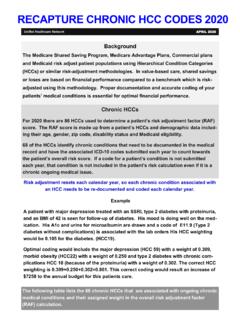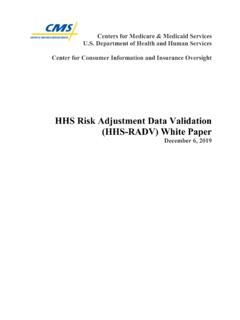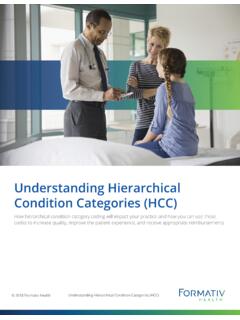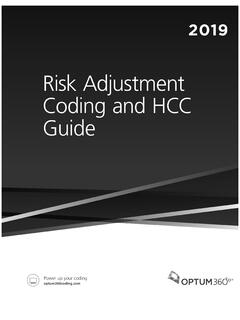Transcription of Hierarchical Condition Categories (HCC)
1 CHI Health Partners Continuing Medical Education Hierarchical Condition Categories (HCC) April 2020 Program Objectives: Describe risk adjustment methodology used by CMS List the criteria to appropriately document and code for HCCs Discuss commonly used HCCs and the medical record documentation required to support appropriate coding Discuss the 2020 update to version 24 and the plan to implement a blended risk score using the 2017 and 2020 risk models Prepared by Henry A. Sakowski II, MD 2 Why the Fuss? The Centers for Medicare and Medicaid Services (CMS) uses a risk-adjusted calculation in order to properly reimburse private insurers that manage Medicare recipients through Medicare Advantage plans and PACE (Program of All-inclusive Care for the Elderly) plans.
2 CMS has expanded the use of this methodology to calculate the benchmark budget goals for Accountable Care Organization (ACO) participants in the Medical Shared Savings Program (MSSP), and it is also being used in the public healthcare exchange. CHI Health Partners participates in the MSSP, Medicare Advantage and exchange plans (Medica with CHI), so it is critical that participating providers fully understand the requirements for proper documentation in the patient medical record, as well the importance of submitting an ICD-10 code for every medical Condition . Similar payment models are be utilized by other third party insurers as they extend managed care products to the private sector.
3 The Managed Medicaid plans in Nebraska and Iowa use a similar risk- adjustment methodology called CDPS + RX (Chronic Illness and Disability Payment System). CDPS is similar to the HCC model, but places a greater emphasis on less common, but costly chronic conditions that are more prevalent among disabled Medicaid beneficiaries. The Hierarchical Condition Categories (HCC) were developed by researchers at Boston University and Harvard with funding from CMS.(1) Their goal was to create a valid risk-adjustment methodology using easily obtainable billing data (diagnosis codes submitted with associated claims) to accurately forecast future health care expenses.
4 Starting with the ICD-9 billing system, the researchers attempted to identify a limited set of diseases and conditions that reliably reflect the extent that an individual s disease burden contributes to his/her healthcare costs. HCCs have been updated periodically to more accurately reflect patient risk and in 2016 were converted to ICD-10 billing codes. Numeric values (weights) were then assigned to each HCC in order to create a predictive tool , the risk adjustment factor (RAF). HCCs accumulate over the calendar year for each patient to determine the RAF along with points contributed by each patient s demographic data (age, gender, an estimate of socioeconomic factors based on zip code information, disability status, and Medicaid eligibility).
5 Some of the HCCs are clustered within a diagnostic group and reflect hierarchies (or severity) among related illnesses. For example, if uncomplicated type 2 diabetes ( ) and type 2 diabetes with nephropathy ( , ) are submitted in the same calendar year, CMS will choose the diagnosis that maps to the HCC indicating a higher severity of illness, HCC 18 (Diabetes with chronic complications) rather than HCC 19 (Diabetes without complications). The RAF for each patient is recalculated each year by adding up all the HCCs submitted the prior year. This means that each chronic Condition must be coded at least once each calendar year in order to provide an accurate risk-adjustment calculation and to budget the appropriate amount of money to care for that patient in the next calendar year.
6 All billing codes (ICD-10) must be supported by documentation in a progress note generated by a face-to-face visit and HCCs + Demographic Data = RAF 3 signed by a qualified provider (a physician or advance practice provider). Each year CMS and other insurers audit medical records to verify that billing accurately reflects care provided. Each performance year that an Accountable Care Organization (ACO) participates with the Medicare Shared Savings Program (MSSP), CMS adjusts the ACO s financial budget to account for changes in the health status of its assigned beneficiaries. Demographic data and HCCs are used to calculate a risk score for all beneficiaries in the ACO.
7 Risk score adjustments are capped at a 3% increase over the 5-year agreement period, however there is no downside cap meaning an ACO s risk score can drop significantly if HCCs are not recoded each year. This makes it essential to properly document and code all chronic conditions to the highest specificity every year a patient is attributed to the ACO. The CMS-HCC Classification System begins with the 70,000+ ICD-10-CM codes and funnels into 805 diagnostic groups, which are further specified to 189 Condition Categories . It is at this point that hierarchies (severity) are imposed among related conditions , hence Hierarchical Condition Categories .
8 For payment year 2020, CMS plans to use two HCC coding methodologies, Version 22 and 24 to produce a blended risk score. Version 22 includes 79 of those 189 HCCs while for version 24, 86 HCCs are active.(2) Over 9500 ICD-10 codes map into one of the HCCs used to risk-adjust the Medicare population.(2) New for 2019/2020 In 2020, CMS added HCC 138 (CKD 3), HCC 55 (drug overdose/poisoning), HCC 56 (Substance abuse disorder), HCC 58 (reactive and unspecified psychosis), and HCC 60 (personality disorders) into the risk scoring methodology. For 2020, HCC 51 (dementia with complications), HCC 52 (Dementia without complications), and HCC 159 (Pressure Ulcer of Skin with Partial Thickness Skin Loss) have been added.
9 What needs to be done? In order for CMS to include an HCC when calculating a beneficiary s risk score and their predicted expenses, a provider s documentation of the face-to-face clinical encounter in the medical record must provide evidence of the diagnosis and its evaluation and/or management plan. The only acceptable data sources are medical records from hospital inpatient facilities, hospital outpatient facilities, physicians (MDs, DOs, DPMs, DCs, ODs) or practitioners (PAs, NPs, CNSs, and Nurse-midwives). CMS requires that all conditions affecting a patient s care, treatment or medical management be documented in the patient s chart and coded.
10 Medical Record While progress notes have historically functioned as a communication tool for providers, they are also used by payers to justify reimbursement based upon the level of care provided. As such, it is essential for providers to document adequately to demonstrate what conditions were diagnosed and/or managed during the encounter: , the care provided. Documentation must MEAT certain requirements , not just a list or code for each Condition , but an indication that the Condition was: Monitored 4 Evaluated Assessed and/or Treated The greatest degree of certainty for each diagnosis must be documented (see linkage section below) Symptoms ( syncope, dyspnea) do not code to an HCC All chronic conditions must be assessed and documented at least once per year If discontinuing treatment for any diagnosed Condition would cause that Condition to resume, ( , medication or pacemaker), then the Condition should be coded and its management documented conditions should be coded to the highest degree of specificity for that encounter (see specificity section below)



